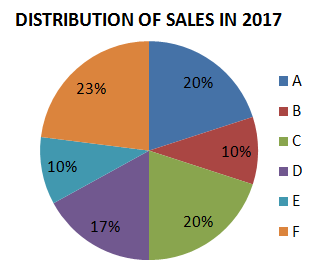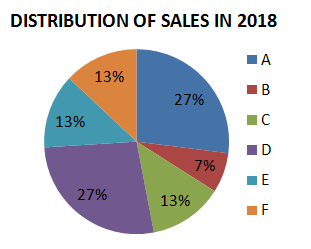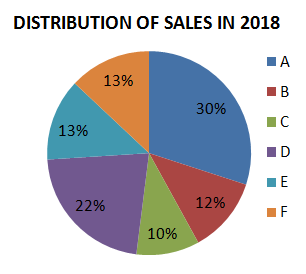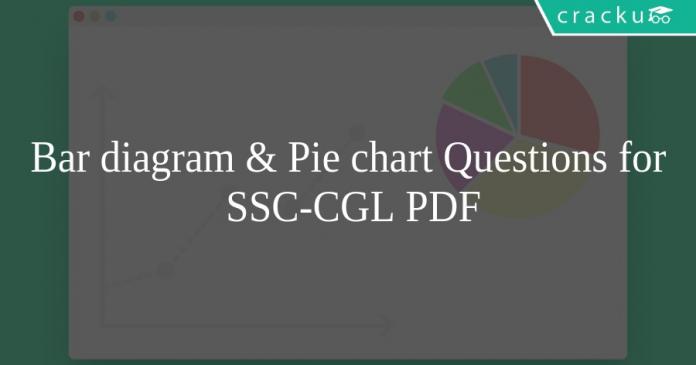Bar diagram & Pie chart Questions for SSC-CGL PDF
Download SSC CGL Bar diagram & Pie chart Questions with answers PDF based on previous papers very useful for SSC CGL exams. Very Important Bar diagram & Pie chart Questions for SSC exams
Download Bar diagram & Pie chart Questions PDF
Get 790+ mocks for Rs. 150 – Coupon PAYPAL
Question 1: The pie chart given below shows the time taken in 7 different procedures J1, J2, J3, J4, J5, J6 and J7 in making a car as a percentage of total time taken. The total time taken in making one car is 1200 hours.

What will be the total taken in procedures J2 and J5?
a) 396 hours
b) 240 hours
c) 312 hours
d) 360 hours
Question 2: The pie chart given below shows the time taken in 7 different procedures J1, J2, J3, J4, J5, J6 and J7 in making a car as a percentage of total time taken. The total time taken in making one car is 1200 hours.

What is the difference between the time taken in processes J1 and J4?
a) 96 hours
b) 72 hours
c) 60 hours
d) 84 hours
Question 3: The bar chart given below shows the ratio of expenditure to revenue for seven consecutive years Y1, Y2, Y3, Y4, Y5, Y6 and Y7.

The profit percentage is lowest for which year?
a) Y4
b) Y7
c) Cannot be determined
d) Y3
Question 4: The bar graph shows the number of cars sold by a distributor in each month from January to June. How many more cars did he sell in the second quarter as compared to the first?

a) 20
b) 25
c) 10
d) 30
Question 5:


The pie charts shows the percentage market share of different companies in the market for the year 2017 and 2018. The total sale increased from 150 crores to 225 crores during 2017 to 2018. What is the ratio of sales of Company D in the year 2018 to its sales in the year 2017?
a) 16 : 21
b) 21 : 16
c) 27 : 20
d) 20 : 27
Question 6: The bar graph shows the number of paintings sold by an art gallery in each month from January to June. How many paintings does it need to sell in July for the 7 month average to be 90?

a) 115
b) 85
c) 90
d) 110
SSC CGL Previous Papers Download PDF
Question 7: The pie charts show the market share of companies in the rice market in 2017 and 2018. The value of sales of Company A in 2017 was ₹40 lakhs. If its sales grew by 25% in 2018, what was approximate value of sales of company B in 2018?


a) ₹12.56 lakhs
b) ₹13.96 lakhs
c) ₹12.96 lakhs
d) ₹13.56 lakhs
Question 8: The pie charts show the market share of the companies in the detergent market in 2017 and 2018. The total size of the market has decreased from ₹ 300 crores to ₹ 200 crores. What is the decrease in the sales of Company F?


a) $14\frac{1}{3}$%
b) $12\frac{1}{3}$%
c) $33\frac{1}{3}$%
d) $13\frac{1}{3}$%
Question 9: The bar graph shows the number of cycles sold by a distributor in each month from January to June. What is the increase in the number of cycles sold in April as compared to March?

a) 75%
b) 78%
c) 68%
d) 70%
Question 10: Study the chart and answer the question based, on the pie chart.
The pie chart given below shows expenditures incurred by a family on various items and savings in a month. Savings of the family is ₹ 8,000 in a month.

The ratio of the expenditure on food to the savings is:
a) 2:1
b) 3:4
c) 3:2
d) 4:3
Question 11: Study the chart and answer the question based, on the pie chart.
The pie chart given below shows expenditures incurred by a family on various items and savings in a month. Savings of the family is ₹ 8,000 in a month.

How much more amount is spent on food than on housing?
a) ₹2,000
b) ₹3,000
c) ₹1,000
d) ₹2,500
Question 12: Study the chart and answer the question based, on the pie chart.
The pie chart given below shows expenditures incurred by a family on various items and savings in a month. Savings of the family is ₹ 8,000 in a month.

What is the total expenditure of the family for the month?
a) ₹45,000
b) ₹48,000
c) ₹50,000
d) ₹40,000
Question 13: DIRECTION: The population of a city is 8000. They have various types of occupation which is given below by the pie-chart. Study the pie-chart and answer the given questions.

The ratio of people working in service to industry sectors respectively:
a) 2:3
b) 3:5
c) 3:4
d) 5:3
Question 14: DIRECTION:The population of a city is 8000. They have various types of occupation which is given below by the pie-chart. Study the pie-chart and answer the given questions.

How much population percent is less in industry sector than in agriculture sector?
a) 10%
b) 25%
c) 15%
d) 20%
Question 15: DIRECTION:The population of a city is 8000. They have various types of occupation which is given below by the pie-chart. Study the pie-chart and answer the given questions.

How much percent are in service sector from the total population?
a) 36%
b) 20%
c) 72%
d) 25%
18000+ Questions – Free SSC Study Material
Answers & Solutions:
1) Answer (D)
Percentage of time taken in J2 = 18%
Percentage of time taken in J5 = 12%
Total time taken = 12+18 = 30% of 1200 = 360 hours
2) Answer (B)
Percentage of time required for J1 = 14%
Percentage of time required for J4 = 8%
Required difference = 14-8 = 6% of 1200 = 72 hours
3) Answer (B)
We know that profit = Revenue – Expenditure
Expenditure : Revenue for Y1 = 0.8 = $\dfrac{80}{100}$
Let Expenditure = 80x, Revenue = 100x
Then, Profit = 100x-80x = 20x
Profit percentage = $\dfrac{20x}{100x}\times100 = 20$%
For Y2,
Profit percentage = $\dfrac{100-75}{100}\times100 = 25$%
For Y3,
Profit percentage = $\dfrac{100-84}{100}\times100 = 16$%
For Y4,
Profit percentage = $\dfrac{100-90}{100}\times100 = 10$%
For Y5,
Profit percentage = $\dfrac{100-70}{100}\times100 = 30$%
For Y6,
Profit percentage = $\dfrac{100-75}{100}\times100 = 25$%
For Y7,
Profit percentage = $\dfrac{100-96}{100}\times100 = 4$%
Hence, The profit percentage is the lowest for Y7
4) Answer (D)
Number of cars sold in first quarter = 100+85+60 = 245
Number of cars sold in second quarter = 95+110+70 = 275
Therefore, 30 more cars sold in second quarter than first quarter.
5) Answer (C)
Sales of D in 2018 = $\dfrac{27}{100} \times 225$
Sales of D in 2017 = $\dfrac{30}{100} \times 150$
Then, Required ratio = $\dfrac{27}{100} \times 225 : \dfrac{30}{100} \times 150 = 27 : 20$
6) Answer (D)
Let the number of paintings to be sold in July = x
Given, $\dfrac{95+78+97+110+60+80+x}{7} = 90$
=> $520+x = 630$
=> x = 110
7) Answer (C)
Value of sales of Company A in 2017 = Rs.40 lakhs
Value of sales of Company A in 2018 = 125% of Rs.40 lakhs = Rs.50 lakhs which is 27% of sales of all companies
27% –> Rs.50 lakhs
7% –> $\dfrac{7 \times 50}{27} = 12.96$ lakhs
8) Answer (D)
Sales of Company F in 2017 = 10% of Rs.300 crore = Rs.30 crore
Sales of Company F in 2018 = 13% of Rs.200 crore = Rs.26 crore
Decrease in sales = $\dfrac{30-26}{30}\times100 = \dfrac{40}{3}$% $= 13\dfrac{1}{3}$%
9) Answer (A)
Number of cycles sold in March = 60
Number of cycles sold in April = 105
Percentage Increase in number of cycles = $\dfrac{105-60}{60}\times100 = \dfrac{45}{60}\times100 = 75$%
10) Answer (A)
The angle subtended by food at the center is 120 degrees and by savings is 60 degrees
Therefore required ratio=120/60
=2:1
11) Answer (A)
let x be total income
Given (60/360)*x=8000
x=48000
difference between food and housing is 120-105=15 degrees
60 degrees=8000
15 degrees=2000
12) Answer (D)
Given 60 degrees=Rs 8000
360 degrees=Rs 48000
Total expenditure=Rs 48000
13) Answer (A)
Total share of service sector=72 degrees
Total share of industry sector=108 degrees
Ratio=2:3
14) Answer (A)
The share of industry sector=108 degrees
The share of agriculture sector=120 degrees
Percent greater=((120-108)/120)*100
=10%
15) Answer (B)
In service sector 72 degrees of share i.e
360 degrees=100
72 degrees=72*100/360
=20%
We hope this Bar diagram & Pie chart Questions for SSC CGL Exam preparation is so helpful to you.





